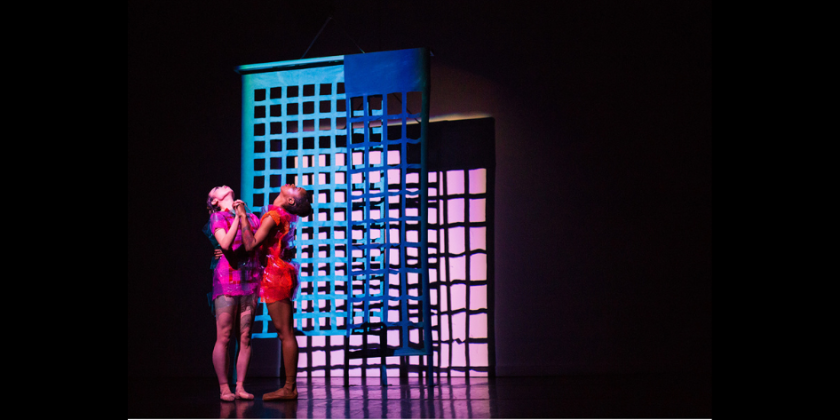IMPRESSIONS: Fall for Dance 2020 Presented by City Center

October 21 and 26, 2020
Choreography: Jamar Roberts, Christopher Wheeldon, Gustavo Ramírez Sansano, Martha Graham, Dormeshia, Kyle Abraham, Lar Lubovitch, George Balanchine
Performance: Jamar Roberts, Sara Mearns, David Hallberg, Ballet Hispanico, Natasha M. Diamond-Walker, Calvin Royal III, Adrian Danchig-Waring, Joseph Gordon, Ashley Bouder, Tiler Peck, and Brittany Pollack, Dormeshia with musicians Noah Garabedian, Winard Harper, and Gabriel Roxbury
Hosted by Alicia Graf Mack and David Hallberg
Fall for Dance is City Center's annual gift to New York City. Every October, a vibrant mix of world-class companies performs new works and beloved classics, which audiences experience for the low price of $15. Like most cultural programming in 2020, the festival has pivoted to accommodate the pandemic, and this year's event has been offered virtually, with only two programs (compared to the usual six). Fall for Dance 2020 features artists exclusively from New York City performing on the City Center stage, so the diversity of our city's dance offerings can be experienced all over the world.

A virtual dance festival presents advantages and challenges for dancers and audiences alike. Audiences not located in New York City have a unique chance to watch these fabulous shows. However, a digital concert fails to capture the specific chemistry between performers and audience that can only take place inside a theater. The videographer's perspective informs how we view the work. In this case, Nel Shelby Productions offers a cinematic, three-dimensional experience. Particularly compelling is witnessing the dancers' facial expressions, which we often miss sitting in the theater.
Each program highlights two world premiere commissions from City Center. A standout is Kyle Abraham's to be seen, choreographed on ABT's newest principal, Calvin Royal III. Though it's impossible to tell from his performance, the two artists only had one day in the studio together before the filming.

to be seen articulates the multi-dimensionality of humans; Royal alternates between vulnerable introspection and decisiveness. Sometimes, he's even a little cocky. He flows between balletic and urban vocabularies, sculpting classical shapes and then dissolving them. His long, sinewy arms luxuriously wrap around his liquid torso and extend like butterfly wings, his fingertips fluttering. As Ravel's "Boléro" intensifies, Royal, with a nearly manic facial expression, responds to the frantic ecstasy of the music with grounded African dance-inspired movements, interlaced with balletic twirling leaps. At the close, he confidently brushes off his face, chest, and shoulder. Smiling triumphantly, he turns and walks into the darkness.
Another world-premiere is Morani/Munju (Black Warrior/Black God), a powerful, meditative self-choreographed solo by Alvin Ailey American Dance Theater's first Resident Choreographer, Jamar Roberts. Like a peaceful warrior, Roberts floats across the stage as his chiseled arms trace lines, sometimes drawing from a Martha Graham-inspired vocabulary. In a prayer-like moment, he leans forward, repeatedly lowering and lifting his palms from the floor.

It wouldn't be Fall for Dance without New York City Ballet. Ashley Bouder, Tiler Peck, and Brittany Pollack perform excerpts from Who Cares?, their brief appearances packing a punch. Bouder is characteristically spritely, beaming at the invisible audience as she conquers a tricky sequence of turns en pointe. Funky little Balanchine signatures, like a hip thrust or a flick of the hand are more visible from the proximity of the video. In less capable hands, Balanchine's abrupt angles, twists, and direction changes could appear awkward or even unflattering, but these world-class dancers execute the challenges seamlessly.
A few works fade into the background. Ballet Hispánico's 18 + 1 Excerpts entertains as an energetic opener, yet feels disjointed, as the three distinct sections do not offer a unifying theme or throughline. The Two of Us, a world premiere by Christopher Wheeldon, couples New York City Ballet principal Sara Mearns and American Ballet Theatre principal David Hallberg for the first time. Choreographed to four Joni Mitchell songs, the maudlin work, seemingly capitalizing on the music's emotion, has the air of a love-sick high schooler daydreaming in her bedroom. Granted, lovely moments occur, like when the duo cycles down a diagonal in a whirling sequence of supported penchée arabesques as Mitchell's "Both Sides Now" builds to a climax. These fabulous dancers deserve something less cliché.

Each program offers one piece that speaks to managing trauma. In Program 1, Martha Graham's Lamentation, performed by Natasha M. Diamond-Walker, manifests grief viscerally. Lar Lubovitch's Duet from Concerto Six Twenty-Two, choreographed in 1985 in response to the AIDS crisis, demonstrates the powerful friendships built through collective struggle. Performed by Adrian Danchig-Waring and Joseph Gordon, a couple offstage, Duet unfolds as a nearly perfect academic composition, yet still conveys deep emotion. Distinct motifs resonate, like in the opening when the pair interlaces their four arms to form two concentric circles, which they repeat at the end. The men experiment with gentle demonstrations of trust — falling backwards into the other's arms, or leaning on an extended leg. Memorably, one of the men scoops something delicate from the ground, cradles it gently, and then lets it fly away. Perhaps, he is grappling with the fragility and transience of life itself.

The second program caps off with another City Center commission, performed and choreographed by Dormeshia and accompanied by musicians Noah Garabedian, Winard Harper, and Gabriel Roxbury. Lady Sings the Blues transports us to a smoky jazz club where the astounding Dormeshia, wearing gold shoes and a shiny top, tap dances with and in response to the swinging percussionists. She smiles in approval as they engage her in a witty call and response. She finishes with her arms dramatically extending into the air, a gesture that implies, "And now I am finished." This closing number reminds us that Fall for Dance embodies all the characteristics of New York City: it is spunky, creative, diverse, and resilient.













